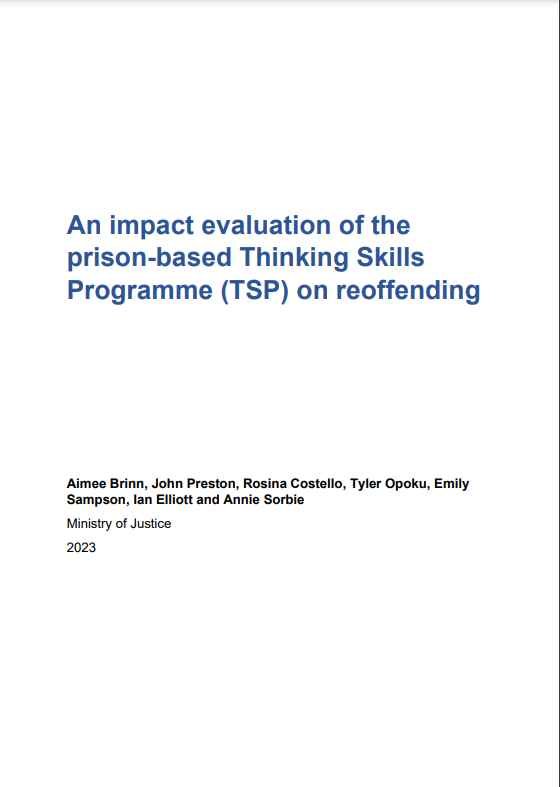An impact evaluation of the prison-based Thinking Skills Programme (TSP) on reoffending
By Aimee Brinn, John Preston, Rosina Costello, Tyler Opoku, Emily Sampson, Ian Elliott and Annie Sorbie
The Thinking Skills Programme (TSP) is an accredited offending behaviour programme designed and delivered by His Majesty’s Prison and Probation Service (HMPPS). TSP is suitable for adult men and women assessed to be at medium and above risk of reoffending. TSP is the highest volume accredited programme delivered in custody.
The TSP is designed to reduce general reoffending by supporting improvements in four ways:
1. Developing thinking skills (such as problem solving, flexible thinking, consequential thinking, critical reasoning)
2. Applying these skills to managing personal risk factors
3. Applying thinking skills to developing personally relevant protective factors
4. Applying thinking skills to setting pro-social goals that support relapse prevention.
The programme format comprises 19 sessions (15 group sessions and 4 individual sessions, resulting in around 38 hours of contact time (dose).
The Evaluation
The aim of this evaluation is to assess the impact of TSP delivered in prison on proven general reoffending within a two-year follow-up period.
The analysis involved a treatment group of 20,293 adults (18,555 males, 1,738 females) who participated in the TSP programme between 2010 and 2019 and this was compared to a matched comparison group of 375,647 adults (345,084 males, 30,563 females) who did not participate in the programme. Propensity score matching (PSM) was used to ensure comparable treatment and comparison groups. The evaluation used the largest number of PSM matching variables for a HMPPS accredited programme evaluation to date.
The evaluation also has a large sample size which means it is likely to be representative of the population of TSP participants. A larger sample generates more precise results and increases the power of statistical testing. This increases the likelihood of finding a statistically significant finding (i.e., not due to chance) even if the difference between the treatment group and the matched comparison group is small. All adults in this study were released from prison between 2010 and 2020.
The impact of TSP was evaluated against three proven general reoffending metrics over a two-year follow up period:
1. Binary measure of reoffending (reoffending rate) – did they re-offend?
2. Frequency of re-offences committed – How many re-offences over the two-year period?
3. Time to first re-offence
Males and females were analysed separately due to the known differences in reoffending behaviour. Headline results include all participants in the programme, separated by gender. Analyses were conducted to investigate the potentially differential effect of TSP participation on distinct subgroups and to provide information on how differences in TSP delivery may impact on its effectiveness. It was not always possible to conduct sub-analyses due to small sample sizes.
Four key sub-analyses (more details are in ‘Explanation of sub-analyses’) were identified as potentially important moderators of TSP effectiveness:
Suitability for TSP (ideally suitable and not ideally suitable)
Completion of TSP (completed and not completed)
Programme integrity using the HMPPS 2016-2019 Interventions Integrity Framework (broadly maintained and compromised)
Risk of reoffending prior to TSP (Offender Group Reconviction Score (OGRS): low, medium, or high risk of reoffending).
Additional sub-analyses were conducted to provide further context and explanation of results included:
Index offence group (acquisitive offences, sexual offences, and OVP (OASys Violence Predictor) offences – based on grouping of Home Office offence codes)
Exclusivity of TSP (participation in TSP only and in one or more other accredited programmes)
Ethnic group (‘Asian and Asian British’, ‘Black, Black British, Caribbean, and African’, ‘mixed and multiple ethnic groups’, and ‘White’, as per Office for National Statistics aggregate categories)
Learning Disabilities and Challenges (LDC) (more likely to present with characteristics associated with LDC and less likely to present with characteristics associated with LDC)
Age (18-25, 26-30, 31-49 and 50+)
London: Ministry of Justice, 2023. 92p.


